Almost all teachers want training in social-emotional learning, but only half actually receive any kind of training—and most of it is incomplete, according to a report from the Collaborative for Academic, Social, and Emotional Learning.
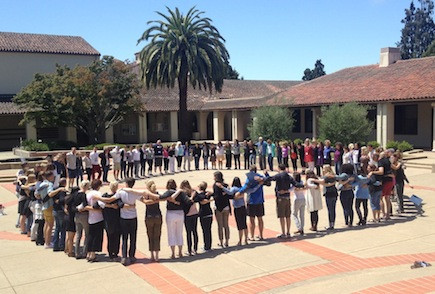 The 2014 GGSC SIE participants
© Jesse Antin
The 2014 GGSC SIE participants
© Jesse Antin
The GGSC is helping to fill that gap through our Summer Institute for Educators, a six-day, five-night retreat for education professionals who want to study the science of social-emotional learning and contemplative practice—as it applies to their own lives, not just to their students’.
This year, we welcomed 93 preschool through university-level teachers, administrators, counselors, leaders, and NGO professionals. It was an extraordinary group, drawn from 13 countries and 22 states. We were truly humbled by their amazing work—and we were honored to provide a space where they could share insights and learn from some of the world’s leading experts in social and emotional skills.
“The whole week had an air of respect for the people here, the research represented, and honor for all of those who have contributed to make this happen,” wrote a pre-K educator from Canada. “It has opened my mind and my heart. I will leave here a different person, bettered by those I have met and, hopefully, a positive influence to those I will encounter after.”
Here are some of the week’s highlights.
“We come into the world exquisitely designed to connect with each other.”
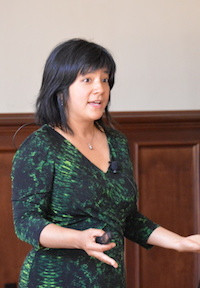 Joyce Dorado at the 2014 SIE.
© Emily Campbell
Joyce Dorado at the 2014 SIE.
© Emily Campbell
Emiliana Simon-Thomas, GGSC’s science director, kicked off the week with an overview of the biology and neuroscience of pro-social behavior, including the caregiving circuitry in the brain, oxytocin, the vagus nerve, voice, and touch.
“We come into the world exquisitely designed to connect with each other,” stated Emiliana, “but have to unearth this tendency because it gets squashed through certain cultural assumptions that are characteristic of Westernized industrial societies.”
UCSF HEARTS co-founder and director Joyce Dorado followed with an explanation of what happens to students when their pro-social circuitry and biology is damaged by complex trauma.
She emphasized the role of the teacher in helping these children to heal, and offered specific tools for educators and school leaders to use in the classroom and school:
I want you to walk away with a sense of hope. Many people like Oprah Winfrey, John Lennon, and Gloria Steinem experienced trauma growing up, but each one had a caring adult who loved them, warts and all, and who said, “I see you. I can’t save you from this, but I’m not leaving.” You get to be that person for young people.
“Mindfulness is a way of returning to normal.”
Megan Cowan and Chris McKenna present at the 2014 GGSC SIE © Emily CampbellNext, Megan Cowan and Chris McKenna of Mindful Schools claimed that deficits within our educational institutions and society are throwing our nervous and emotional systems out-of-whack.
“If we’re always ‘doing’ from morning to bedtime,” said Megan, “then we’re losing connection with what makes us a human being.”
The solution, she argued, lies in cultivating a kind, non-judgmental, moment-to-moment awareness of our thoughts, feelings, and surroundings: “Mindfulness is a way of returning to normal. It’s the first time many adults and students are being given permission to not be defending or assessing or orienting outwards. It’s the first time it’s safe to stop.”
In addition to taking participants through several mindfulness practices that could easily be used in the classroom, Megan and Chris emphasized the importance of a teacher’s personal practice of mindfulness. Teachers who make us feel seen, valued, and important all have one thing in common, said Megan: “Their presence, which can’t be faked—a presence that comes from a deep place inside them because of who they are.”
“With mindfulness,” asserted Chris, “it’s not the curriculum that matters most, but the attitude you’re bringing with it.”
“Experiencing all the emotions in a rich and balanced way”
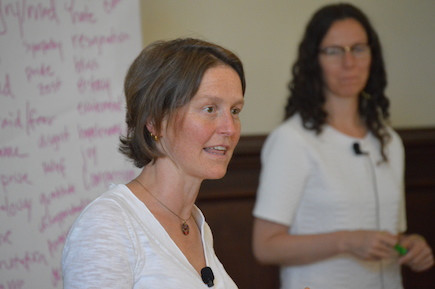 Emiliana Simon-Thomas and Brooke Dodson-Lavelle present at the 2014 GGSC SIE
© Emily Campbell
Emiliana Simon-Thomas and Brooke Dodson-Lavelle present at the 2014 GGSC SIE
© Emily Campbell
Emiliana and Brooke Dodson-Lavelle, senior program officer at the Mind and Life Institute, began their workshop on empathy and compassion with a description of how emotions and cognition work together.
The dichotomy between thinking and feeling is a false one, said Emiliana. “They both occur as a result of synchronous engagement of multiple systems in the brain that are signaling something about the environment.” This understanding has major implications for the field of education, which, historically, has focused solely on the cognitive development of students and almost completely ignored their emotional development.
Emiliana was quick to point out that having positive emotions all the time is not the ultimate goal. “The people who are the healthiest and happiest,” she said, “are those who can experience all the emotions in a rich and balanced way—not necessarily the ones who are always the happiest.”
Emiliana went on to explain that burnout often arises from focusing too much on others’ needs and feelings, without addressing our own. “If, while talking to someone, you’re taking on that person’s experience and then resolving that experience within yourself, you’re actually not helping the person because you’re just trying to make yourself feel better,” she said.
Instead, we should notice our empathic response in an open-minded, non-judgmental way, let the emotions settle, and then consider how to compassionately help the other person. In other words, we have to listen with mindfulness.
Moving onto self-compassion, Brooke and I described how the cultivation of self-compassion may be an antidote to the pitfalls of the self-esteem movement, and could help students who suffer from fear of failure.
However, rather than using self-compassion solely as a soothing mechanism when things get tough, Brooke challenged participants to go deeper through the use of tools for examining the beliefs and thoughts that are causing difficult emotional responses in the first place.
“Forgiveness emerges when you’re at peace.”
 Fred Luskin presents at the 2014 GGSC SIE
© Emily Campbell
Fred Luskin presents at the 2014 GGSC SIE
© Emily Campbell
Forgiveness expert Fred Luskin spent much of his workshop helping participants to relax. “Because,” he stated, “as we learned at the Stanford Forgiveness Project, forgiveness emerges when you’re at peace.”
According to Fred, this fast-paced world keeps our nervous system adrenalized, keeping us engaged in narrow, threat-based processing—the part of us that doesn’t forgive.
“None of us realize how desperate we are all day long because we don’t feel valued, loved, or safe—and expect the world to make us so. We think ‘when I buy this or accomplish this, I’ll be okay.’ That’s crazy-making.”
Making peace with the word “no” opens up new possibilities for peace.
“Forgiveness emerges from someone who is not desperate for this world to be perfect, to be treated perfectly, or for everything to work out as expected,” explained Fred. “When you’re at peace, you’re naturally forgiving. I swear it’s this simple. It’s not easy, but it is this simple.”
“When you make a friend from an out-group, something special happens.”
 Rudy Mendoza-Denton presents at the 2014 GGSC SIE
© Emily Campbell
Rudy Mendoza-Denton presents at the 2014 GGSC SIE
© Emily Campbell
In his workshop on overcoming racism and prejudice, GGSC Faculty Director Rudy Mendoza-Denton stated that simple intergroup contact can reduce prejudice— but intergroup friendship is even better.
“When you make a friend from an out-group, something special happens,” said Rudy. “You begin to incorporate the identity of that person into who you are. That’s when dehumanizing another becomes much more difficult.”
But the conditions have to be right for students to cross those boundaries, in particular the identification of peer leaders. “Sometimes the blowups that happen between students don’t reflect the students’ actual values,” stated Rudy, “but rather values that are endemic to the school itself.”
Thus, popular students who are asked to publicly denounce harassment and discrimination can play a powerful role in changing school norms.
“Use the mind to change the brain to change the mind for the better.”
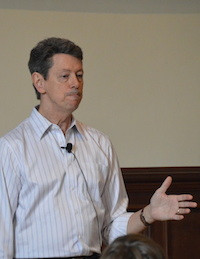 Rick Hanson presents at the 2014 GGSC SIE
© Emily Campbell
Rick Hanson presents at the 2014 GGSC SIE
© Emily Campbell
Neuropsychologist and best-selling author Rick Hanson taught participants his method for “Taking in the Good” (TIG), a practice that draws on the science of neuroplasticity to help us become more skillful at managing the inevitable ups and downs of life.
“My material is about growing our inner resources—moments in which we feel mindful, determined, loving, cared about, worthy, accomplished, resilient—so that we can use the mind to change the brain to change the mind for the better,” said Rick.
He also encouraged participants to use this method with students, including those with ADHD. “ADHD children move so fast that their positive experiences get dislodged by the next incoming experience,” explained Rick. TIG helps them to stop and focus on what they’ve just experienced so that it can get imprinted into their brains.
When teaching students to take in the good, Rick suggested that teachers be very matter of fact with them. “Teaching them this practice will make them feel like they’re participants in their education. It will also help them see the good in the world and others and to view life as an opportunity.”
“Just by virtue of your presence… you will begin to change your school environment.”
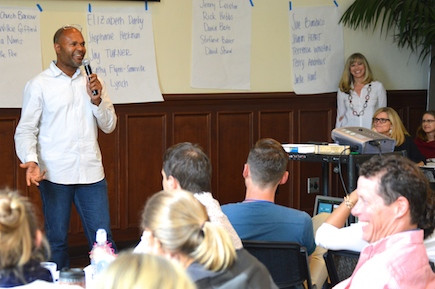 Chris Murchison and Monica Worline present at the 2014 GGSC SIE
© Emily Campbell
Chris Murchison and Monica Worline present at the 2014 GGSC SIE
© Emily Campbell
One of the challenges participants face when they go back home is convincing colleagues to embrace SEL and mindfulness. But, said positive organizational scholarship expert Monica Worline, “Just by virtue of your presence and by virtue of changing the conversation with people around you, you will begin to change your school environment.”
She and Chris Murchison, Vice President of Staff Development and Culture at HopeLab, described two ways to think about organizational change: in-scaping and micro-moves.
“In-scaping is thinking about how to get a whole school to change, and a micro-move is the small thing that I’m going to do today to create the school that I want,” said Monica.
Some of Chris’s favorite micro-moves are staff meeting check-ins. “These are opportunities to check-in with each other,” he explained, “to see how everyone is doing, to connect in a deeper way, to press the pause button and breathe that gets everyone present. ‘Check-ins’ can humanize meetings.”
Connecting all the dots
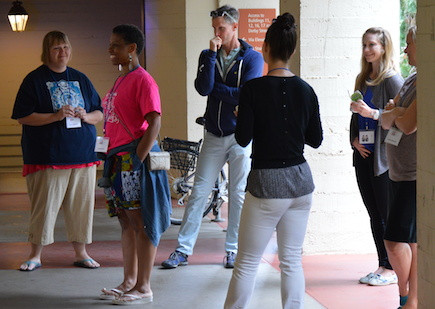 A "family" group of 2014 SIE participants takes part in a team-building exercise
© Emily Campbell
A "family" group of 2014 SIE participants takes part in a team-building exercise
© Emily Campbell
In between speakers, participants were asked to reflect on what they valued most in their lives and in their work, and how what they were learning could help them better live those values.
To deepen this reflection, we created “families”—small groups of seven to ten participants that spent the week together discussing and playing and laughing about their challenges, their triumphs, and their “a-ha” moments. As one community college instructor wrote. “I think putting us in family groups and creating bonding activities was brilliant. I felt safe, at home, and blessed, which made the learning come easier.”
The joy felt at the end of the Institute shows what is possible in a learning environment in which everyone involved has a deeper understanding of how to cultivate our innate goodness and also what gets in the way of doing so. Where, when things get tough, people ask, “What happened to you?” rather than “What’s wrong with you?” And then respond with empathy and compassion.
“This conference has raised my level of consciousness to understand that by developing one’s self, one creates opportunities to lift the lives of others,” wrote another participant, a university educator from New York. “By learning to value and love one’s self, one has the opportunity to create a world for the greater good.”
Applications for the 2015 Greater Good Science Center Summer Institute for Educators are now being accepted until January 1. Click here to apply.

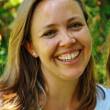
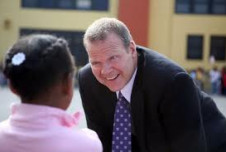
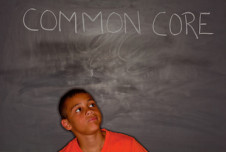
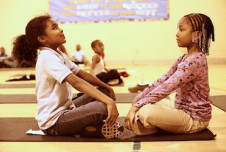
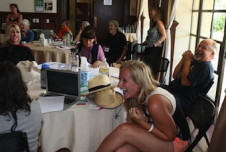
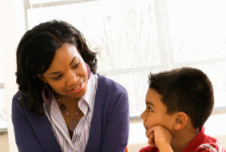

Comments